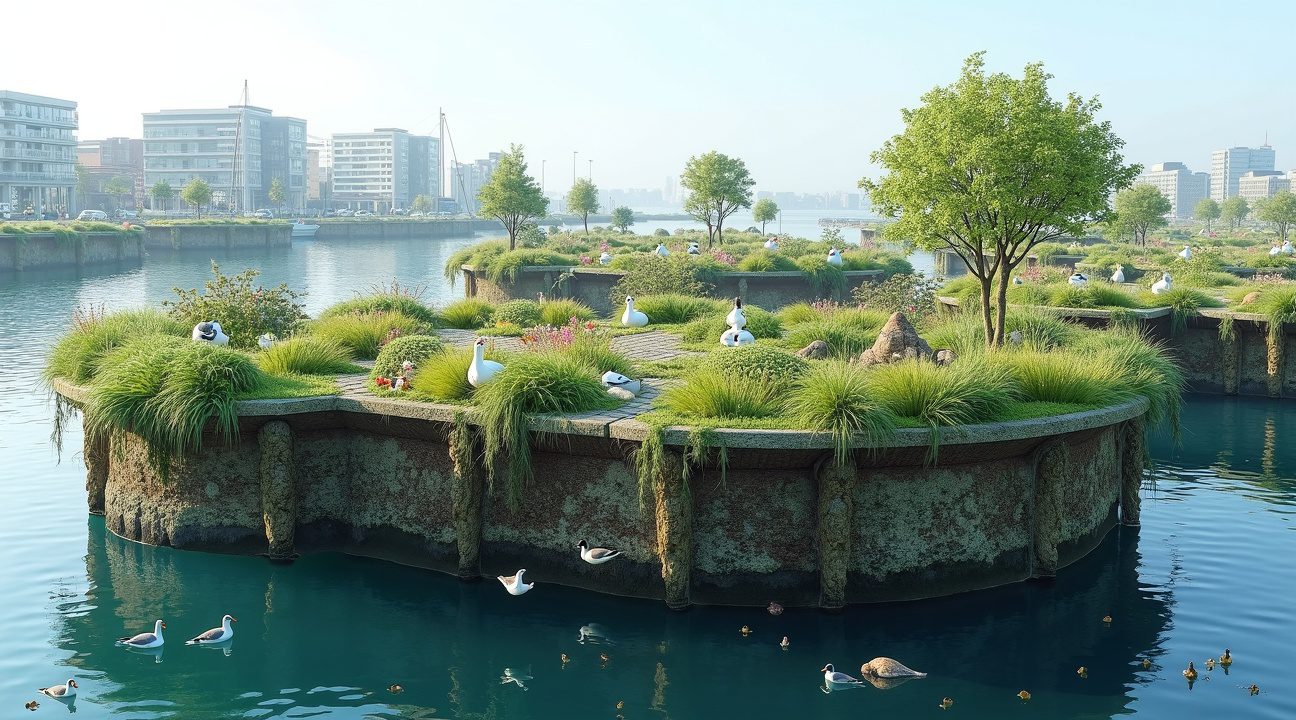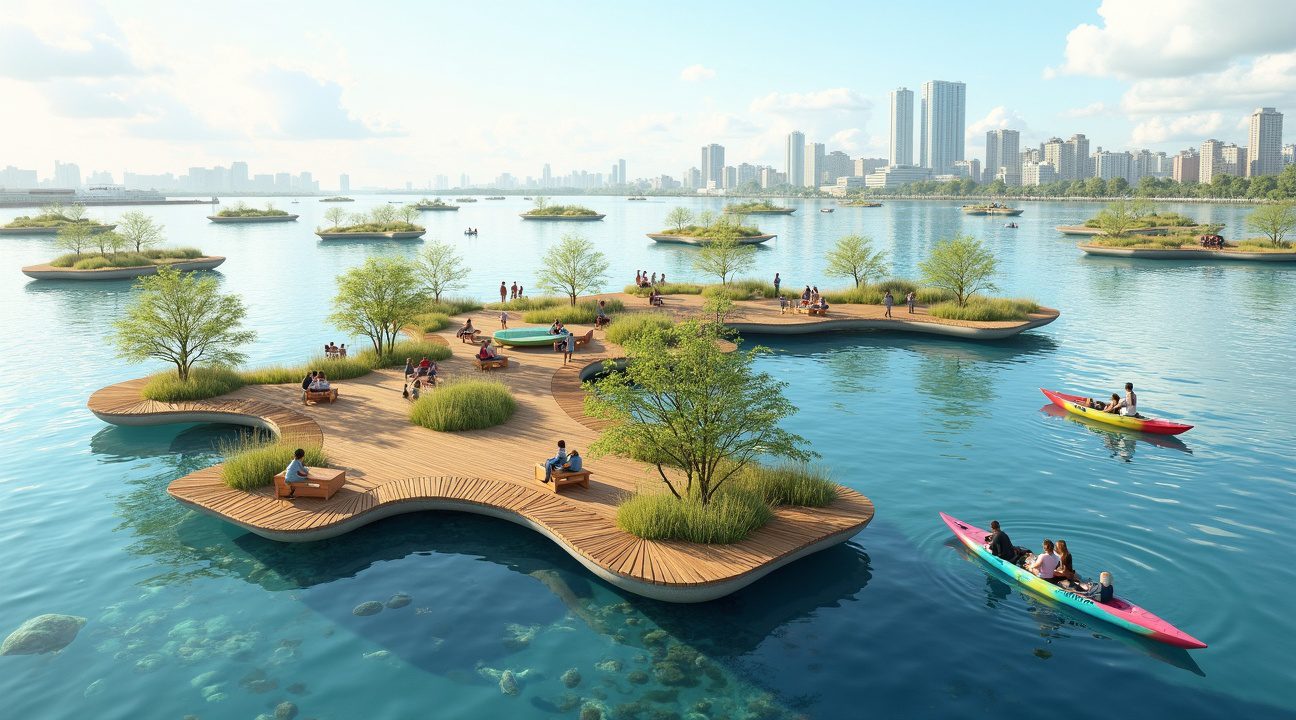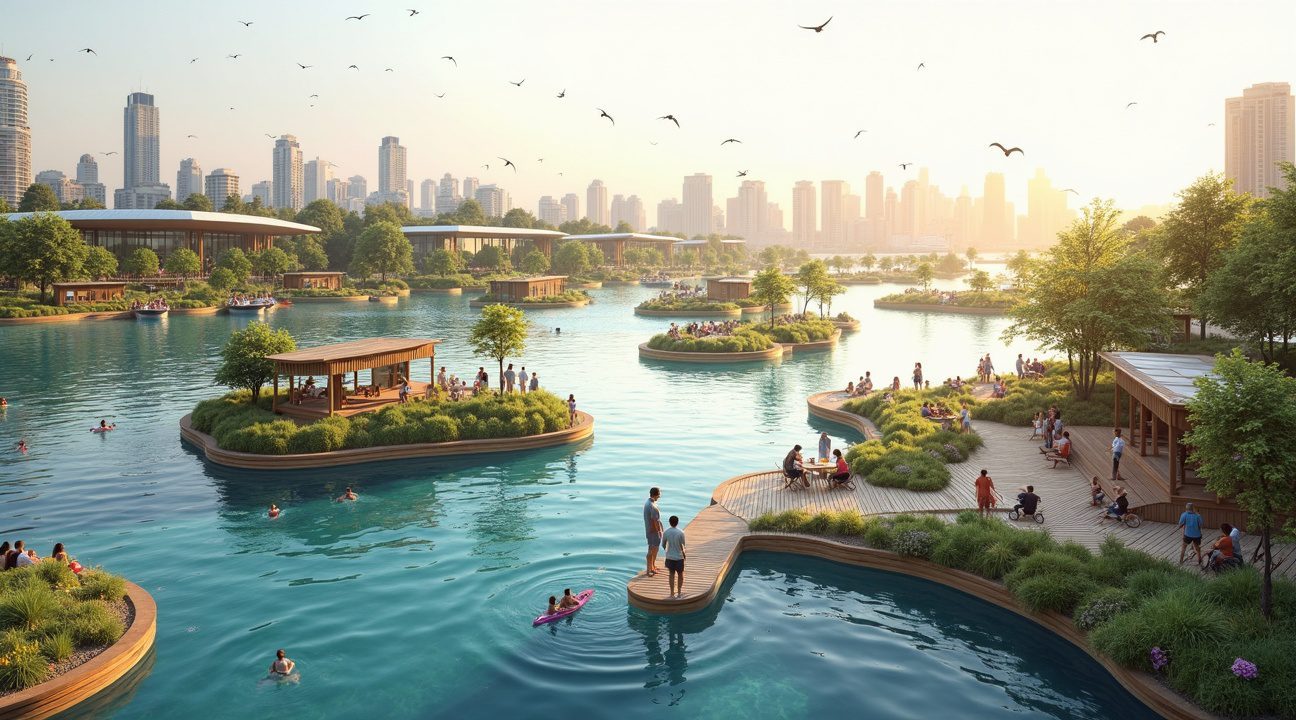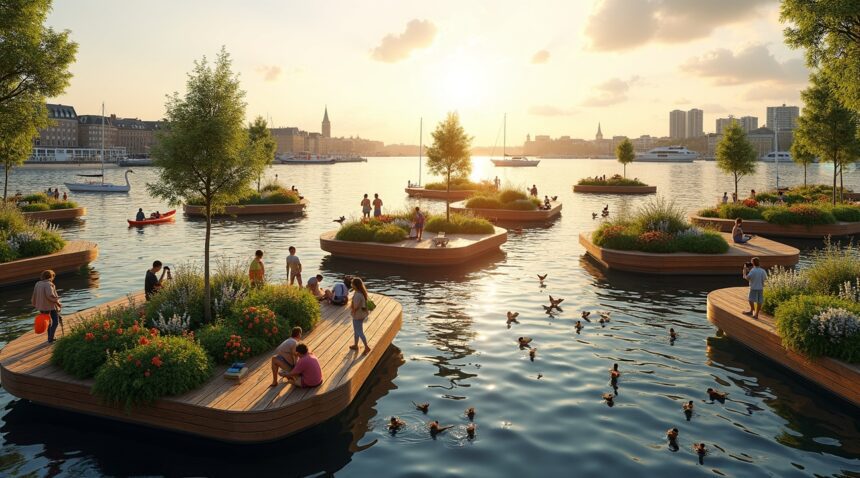Copenhagen’s innovative floating islands project transforms urban harbors into thriving ecosystems that support birds, bees, and fish while providing free public access to previously restricted waterfront areas.
Key Takeaways
- Multi-species habitat creation: The floating islands support diverse wildlife above and below water, from nesting seabirds and pollinating bees to fish and marine organisms that thrive around the artificial reef structures.
- Climate-resilient design: Built with recycled materials and flexible anchoring systems, these islands adapt to rising sea levels and changing weather patterns while requiring minimal maintenance compared to traditional fixed infrastructure.
- Free public accessibility: All islands remain open for community use, allowing residents to kayak, swim, picnic, and observe wildlife in areas that were previously inaccessible or restricted.
- Modular and mobile configuration: The islands can be repositioned based on seasonal needs, connected for larger events, or relocated to optimize conditions for both wildlife and human activities.
- Ambitious expansion plans: Following the success of the initial prototype CPH-Ø1, Copenhagen is developing additional islands including a nine-module installation with satellite habitats to create a comprehensive harbor ecosystem network.
Sustainable Urban Innovation
The floating islands illustrate how cities can apply nature-based solutions to combat biodiversity loss and adapt to climate impacts. By integrating modular design, ecological planning, and community engagement, Copenhagen has created a scalable model for urban renewal through green infrastructure.
You can learn more about this inspiring project on Studio Fokstrot’s official website, where the team behind the floating islands shares updates and design insights.
Copenhagen’s Floating “Parkipelago” Creates New Wildlife Havens in Urban Waters
Copenhagen’s harbors are experiencing a remarkable transformation through an innovative project that brings nature back to the urban waterfront. Copenhagen Islands, a groundbreaking not-for-profit initiative, demonstrates how creative design can breathe new life into forgotten city waters.
Architect Marshall Blecher partnered with Danish design studio Fokstrot to develop this visionary concept. Their goal extends beyond simple beautification—they’re actively working to revitalize old city harbors while introducing much-needed urban green spaces. Their approach is particularly compelling because it addresses multiple urban challenges simultaneously: limited green space, declining biodiversity, and underutilized waterfront areas.
The “Parkipelago” Concept
The team coined the term “parkipelago” to describe their unique solution—an archipelago of mobile, floating islands that serve the public while enhancing biodiversity in urban environments. These floating platforms aren’t just artistic installations; they function as genuine habitats for various species while providing recreational spaces for city residents.
What makes this initiative especially accessible is that all islands remain free for public use. Citizens can kayak to these floating green spaces, use them for picnics, or simply observe the wildlife that gradually makes these platforms home. The mobility aspect allows organizers to relocate islands based on seasonal needs, water conditions, or community events.
From Prototype to Proof of Concept
The project’s first tangible result came in 2018 with the launch of CPH-Ø1, the initial prototype that validated the entire concept. This 25-square-meter platform showcased the potential of floating urban nature reserves. Builders employed traditional wooden boatbuilding techniques, creating a structure that harmonizes with Copenhagen’s maritime heritage while serving contemporary environmental needs.
CPH-Ø1’s success opened doors for expanding the parkipelago throughout Copenhagen’s harbor system. Denmark’s commitment to innovation becomes evident through projects like this, where design thinking meets environmental stewardship.
The floating islands provide critical breeding grounds and resting spots for birds migrating through urban areas. Fish find shelter and feeding opportunities around the submerged portions of these structures. Pollinators discover new sources of nectar from carefully selected plant species that thrive in marine environments.
Each island serves as a small-scale ecosystem, proving that even modest interventions can create significant positive impacts on urban biodiversity. The project demonstrates how thoughtful design can transform neglected waterways into vibrant, living spaces that benefit both wildlife and human communities.

Birds, Bees, and Fish Find New Homes on Man-Made Island Habitats
I find Denmark’s floating islands remarkable for their ability to support diverse urban wildlife across multiple ecosystems. These innovative structures create habitat layers that accommodate everything from soaring seagulls to bottom-dwelling mollusks, transforming sterile harbor environments into thriving ecological communities.
Multi-Species Habitat Creation
Above the waterline, these floating platforms welcome an impressive variety of bird species that have adapted to urban environments. Seagulls establish nesting colonies on the islands’ surfaces, while swans and ducks use the structures as resting points during migration or daily feeding routines. Pigeons find shelter in the planted vegetation, creating a vertical habitat that extends from water level to treetop.
Insects discover new opportunities on these floating sanctuaries, with bees particularly benefiting from the diverse plant life. The islands provide crucial pollinator habitat in areas where concrete and steel typically dominate. This insect activity creates a ripple effect throughout the ecosystem, supporting bird populations that depend on insects for food while also facilitating plant reproduction across the harbor area.
Beneath the surface, I observe how the floating structures create equally important aquatic habitats. The undersides of these islands offer perfect attachment points for seaweed, mussels, and various mollusk species. These organisms form the foundation of marine food webs, filtering water while providing sustenance for fish populations. The artificial reef effect extends the habitat’s value deep into the water column.
Native Plant Integration and Ecological Impact
Each floating island features carefully selected endemic trees, grasses, and bushes that support native Danish species. This plant selection isn’t random—designers choose vegetation that can withstand marine conditions while providing maximum ecological benefit. Native grasses create nesting materials and food sources for small birds, while trees offer perching spots and shelter for larger species.
The micro-habitat approach allows these islands to function as stepping stones for wildlife movement throughout urban areas. Birds can travel between islands and mainland green spaces, expanding their range and genetic diversity. Fish populations benefit from the increased structural complexity underwater, which provides protection from predators and creates feeding opportunities.
These floating structures serve a dual purpose by reintroducing wilderness elements to heavily developed waterfronts. Areas that underwent extensive gentrification often lose their natural character, but floating islands restore ecological function without sacrificing urban development. The structures seamlessly integrate into harbor environments while providing environmental services that benefit both wildlife and human residents.
The expansion of green infrastructure through floating islands addresses urban biodiversity loss in innovative ways. Traditional parks and green spaces face limitations in harbor areas where land is scarce and expensive. Floating solutions circumvent these constraints while creating habitat that wouldn’t exist otherwise. The islands demonstrate how cities can increase their ecological footprint without expanding their physical boundaries.
Water quality improvements emerge as an additional benefit of these multi-species habitats. The combination of plant life above and filter-feeding organisms below creates natural water treatment systems:
- Seaweed and mollusks remove excess nutrients from harbor water
- Plant roots help stabilize sediments
- Floating vegetation reduces erosion
The success of Denmark’s floating islands provides a model for other coastal cities facing similar challenges. These structures prove that urban development and wildlife habitat can coexist, creating win-win scenarios for both human communities and local ecosystems. The approach transforms harbors from industrial spaces into dynamic environments where nature and city life intersect in meaningful ways.
Just as marine life returns to restored environments, Denmark’s floating islands demonstrate how thoughtful design can bring biodiversity back to urban waters.

Ingenious Design Features Make Islands Both Mobile and Sustainable
I’m impressed by how these floating islands combine environmental responsibility with practical functionality through their clever construction methods. The foundation relies on steel frameworks paired with recycled flotation materials, creating a stable base that doesn’t compromise the water’s ecosystem. FSC-certified sustainable timber completes the structure, ensuring every component meets strict environmental standards while providing the durability needed for marine conditions.
Flexible Configuration Adapts to Community Needs
The mobility aspect sets these islands apart from traditional fixed installations. I can anchor them in different harbor locations based on seasonal wildlife patterns, water conditions, or community events. When special occasions arise, multiple islands connect together to form larger gathering spaces, then separate back to their individual positions for everyday use. This modular approach allows organic growth and adaptation as the harbor’s needs evolve.
The flexible anchoring system means I can relocate islands to optimize sunlight exposure for plant growth or position them in calmer waters during harsh weather. Wildlife benefits from this mobility too, as different harbor zones offer varying depths, currents, and shelter conditions that suit different species throughout the year.
Accessibility transforms these floating platforms into genuine public spaces rather than distant viewing points. Visitors reach the islands by boat, kayak, or swimming directly from shore, making them an integral part of the harbor experience. I’ve seen families use them for waterside picnics, artists display exhibitions on the timber decking, and swimmers treat them as rest stops during longer harbor swims.
The design accommodates multiple user groups simultaneously without conflicts:
- Children can safely explore the planted areas
- Adults appreciate the harbor views from comfortable seating areas
- The sustainable timber decking provides slip-resistant surfaces for wet feet and paws
- Strategically placed vegetation creates natural windbreaks and privacy zones
Each island functions as both habitat and recreation space, with native plants attracting pollinators and providing nesting sites for seabirds. Fish congregate beneath the floating structures, creating natural feeding grounds that benefit the entire harbor ecosystem. The recycled materials demonstrate that sustainability doesn’t require sacrificing functionality or aesthetics.
These design choices reflect Denmark’s commitment to progressive environmental solutions that enhance urban life. The islands prove that innovative engineering can create spaces where human recreation and wildlife conservation complement each other perfectly. Every element serves multiple purposes, maximizing both environmental benefits and community value within the limited space of busy urban harbors.

Climate-Resilient Solution Adapts to Rising Sea Levels and Urban Challenges
Copenhagen’s floating islands represent a groundbreaking approach to climate-resilient urbanism, demonstrating how cities can transform concrete waterfronts into adaptive ecosystems. I’ve observed how these innovative structures address multiple urban challenges simultaneously while preparing for an uncertain climate future.
Sustainable Materials Drive Environmental Innovation
The construction of these floating habitats relies heavily on recycled and sustainably sourced materials, creating a circular economy model that reduces waste while building new ecosystems. The project team carefully selected materials that could withstand marine environments without leaching harmful substances into the water. Recycled timber forms the primary structural framework, while repurposed plastic components provide buoyancy and durability.
Sustainable cork serves as insulation and growing medium, offering excellent water retention properties that support plant establishment. Local sourcing of materials reduces transportation emissions while supporting regional suppliers. The material selection process prioritizes longevity and end-of-life recyclability, ensuring these islands can adapt and evolve without creating future waste streams.
Adaptive Design Responds to Climate Challenges
The mobility and flexible design of these floating islands enable Copenhagen to respond dynamically to rising sea levels and changing weather patterns. Unlike fixed infrastructure, these islands can be repositioned as water levels fluctuate or as urban needs change. Their modular construction allows for expansion or reconfiguration based on seasonal requirements or ecosystem development.
The islands’ ability to rise and fall with water levels eliminates the need for costly sea walls or elevated structures. During storms, the flexible anchoring system allows the islands to move with wave action rather than fighting against it. This adaptive approach reduces maintenance costs while providing consistent habitat regardless of water level variations.
I’ve noted how this project exemplifies a fundamental shift from rigid concrete waterfronts to nature-based solutions that work with natural systems rather than against them. Traditional harbor infrastructure requires constant maintenance and eventual replacement as climate conditions change. These floating ecosystems, however, become more stable and resilient as vegetation establishes and wildlife populations grow.
The islands support urban resilience by providing multiple ecosystem services simultaneously. They filter stormwater runoff, reduce wave action that could damage traditional infrastructure, and create microclimates that help moderate urban heat islands. Fish populations benefit from new spawning areas and shelter, while birds gain crucial stopover points during migration.
Long-term ecological health improves as these islands mature into complex habitats. The design incorporates different depth zones and substrate types to support diverse species throughout their life cycles. Native plant species establish root systems that further stabilize the structures while providing food sources for insects and birds.
Recognition from the Taipei International Design Award for Public Space validates this innovative approach to urban ecological design. The project also received an award for Social Design, acknowledging how these islands create community gathering spaces while addressing environmental challenges.
The success of Copenhagen’s floating islands has influenced urban planning discussions globally. Cities facing similar climate pressures are studying this model for potential adaptation to their own waterfront challenges. The scalable nature of the design makes it applicable to various urban contexts, from Denmark’s royal city harbors to industrial ports requiring ecological enhancement.
Local communities have embraced these islands as educational platforms where residents can observe urban wildlife up close. Schools organize field trips to study ecosystem development in real time, while researchers monitor species colonization patterns and habitat effectiveness. The islands serve as living laboratories that generate valuable data for future climate adaptation projects.
The integration of technology enables remote monitoring of water quality, wildlife activity, and structural integrity. Sensors track environmental conditions and alert maintenance teams to any required interventions. This data-driven approach ensures optimal performance while minimizing human disruption to developing ecosystems.
Free Public Access Transforms Restrictive Waterfronts into Community Spaces
Denmark’s floating islands represent a revolutionary approach to urban waterfront development, prioritizing community access over commercial exclusivity. These innovative structures break down the barriers that typically separate city residents from their natural waterways, creating inclusive spaces where everyone can connect with marine ecosystems.
The floating islands serve as dynamic community hubs that host an impressive range of activities throughout the year. Visitors can participate in educational talks about marine conservation, attend environmental exhibitions, or simply enjoy recreational pursuits like fishing and swimming in previously inaccessible harbor areas. Star-gazing enthusiasts find these platforms offer unique vantage points away from city lights, while families discover perfect spots for waterside picnics.
Breaking Down Traditional Waterfront Barriers
Most urban waterfronts around the world have become increasingly privatized or restricted, limiting public access to valuable coastal resources. I’ve observed how many cities treat their harbors as industrial zones or exclusive commercial developments, effectively cutting off residents from their natural heritage. Denmark’s floating islands challenge this trend by establishing public accessibility as a fundamental design principle.
These structures demonstrate that urban development doesn’t have to exclude community engagement. The islands create opportunities for people of all ages and backgrounds to experience marine environments firsthand, fostering a deeper connection between urban populations and aquatic ecosystems. This accessibility encourages environmental stewardship while providing recreational benefits that improve quality of life.
Expanding Vision Through the Blue Plan
The Blue Plan, developed by Tredje Natur and PK3, outlines an ambitious expansion of the floating island concept with specialized themed installations. Each proposed island would serve distinct purposes while maintaining the core principle of public accessibility.
- Wildlife observation platforms would offer dedicated spaces for birdwatching and marine life study, equipped with educational materials and guided viewing opportunities.
- Water sports islands would support activities like kayaking, paddleboarding, and sailing instruction.
- Educational islands would function as outdoor classrooms for schools and community groups, providing hands-on learning experiences about marine biology, sustainability, and environmental science.
This comprehensive approach ensures that the floating network serves diverse community interests while advancing biodiversity conservation goals.
The genius of this approach lies in its ability to combine recreation, education, and environmental restoration within a single framework. Rather than treating these objectives as competing priorities, the floating islands demonstrate how thoughtful design can achieve multiple benefits simultaneously. Visitors enjoy recreational activities while contributing to ecosystem monitoring and learning about marine conservation.
These floating spaces also address urban density challenges by creating new public areas without requiring additional land development. As cities worldwide face increasing pressure to provide green space for growing populations, Denmark’s model offers a scalable solution that can be adapted to various coastal and harbor environments.
The success of these installations has already inspired Denmark’s environmental leadership on the international stage. Communities across Europe are studying the floating island model as a potential solution for their own waterfront accessibility challenges.
The transformation from restricted harbors to inclusive community spaces represents more than just urban planning innovation. It reflects a fundamental shift in how cities can prioritize both environmental health and social equity. By ensuring that everyone can access and benefit from these floating ecosystems, Denmark creates a powerful example of sustainable development that puts community needs at the center of environmental restoration efforts.
These floating islands prove that environmental conservation and public engagement aren’t mutually exclusive goals. Instead, they can work together to create stronger, more resilient communities that actively participate in protecting their local ecosystems while enjoying unprecedented access to urban waterways.

More Floating Islands Planned as Project Expands Across Copenhagen Harbor
The initial success of CPH-Ø1 has sparked ambitious expansion plans throughout Copenhagen Harbor. I’ve learned that at least three additional islands—designated CPH-Ø2, CPH-Ø3, and beyond—were greenlit for deployment as the project gains momentum. Each new installation builds upon lessons learned from the prototype while adapting to specific harbor locations and local wildlife needs.
Scaling Up with Modular Design
The largest planned habitat represents a significant leap in scope and complexity. This expanded installation will feature nine interconnected modules supported by satellite islands, creating a comprehensive ecosystem that serves both wildlife and human recreational purposes. The modular approach allows each component to function independently while contributing to a larger environmental network.
Key features of the expanded system include:
- Enhanced nesting areas spread across multiple elevation levels
- Specialized zones for different bird species and marine life
- Increased plant diversity to support various pollinators
- Integrated seating and observation areas for public engagement
- Strategic positioning to maximize tidal flow and water circulation
What sets this project apart is its inherently flexible design philosophy. Rather than following a rigid master plan, the floating island initiative adapts as community needs shift and environmental priorities evolve. This approach mirrors other transformative changes happening across Denmark, where traditional approaches give way to innovative solutions.
The expansion strategy prioritizes organic growth over predetermined timelines. Each new island undergoes careful site assessment, considering factors like water depth, existing marine traffic, and potential wildlife migration patterns. Local environmental groups provide ongoing feedback, ensuring that each installation addresses specific ecological gaps within the harbor ecosystem.
Copenhagen’s harbor authority works closely with marine biologists to optimize placement of these artificial habitats. The goal extends beyond simply adding green space—each island must contribute meaningfully to biodiversity while enhancing the urban waterfront experience. Early monitoring data from CPH-Ø1 informs design modifications for subsequent installations, creating an iterative improvement process.
The project’s scalability attracts attention from urban planners worldwide. Cities facing similar challenges with limited green space and declining urban wildlife populations study Copenhagen’s approach for potential adaptation. The floating island concept offers particular promise for coastal cities where traditional park development faces space constraints.
Funding for the expansion comes through a combination of municipal investment and private partnerships. Local businesses recognize the tourism potential of these unique installations, while environmental organizations support the biodiversity benefits. This collaborative funding model ensures project sustainability while maintaining focus on ecological objectives.
Construction timelines for additional islands depend on manufacturing capacity and seasonal installation windows. Winter months limit deployment opportunities due to weather conditions, concentrating installation activities during spring and summer periods. Each island requires several weeks of on-site assembly and stabilization before wildlife introduction begins.
The satellite island concept introduces interesting possibilities for specialized habitats. Smaller modules can target specific species or provide focused functions like fish spawning areas or butterfly gardens. This diversity creates micro-environments within the larger harbor ecosystem, supporting a broader range of wildlife than single-purpose installations.
Community engagement remains central to expansion planning. Regular public meetings gather input from harbor users, nearby residents, and environmental advocates. This feedback shapes both individual island designs and overall network configuration. The participatory approach builds local ownership while ensuring installations meet diverse stakeholder expectations.
Technical innovations continue emerging as the project evolves. Advanced anchoring systems reduce environmental impact on harbor floors, while improved plant selection enhances survival rates in marine environments. Each iteration incorporates technological advances that improve both functionality and longevity.
The expansion demonstrates how urban infrastructure can adapt to support both human activities and wildlife conservation. Rather than viewing these as competing priorities, Copenhagen’s floating islands prove that thoughtful design creates mutually beneficial solutions. This philosophy influences other municipal projects, establishing a new standard for sustainable urban development.

Sources:
BrightVibes – “Floating islands introduce a novel type of public space to Copenhagen”
Dezeen – “Marshall Blecher and Studio Fokstrot build Copenhagen Islands”
DETAIL.de – “Floating Island in Copenhagen”
Copenhagen Islands – “More Sports. More Architecture.”
Dezeen – “Blue Plan for Copenhagen Harbour by Tredje Natur and PK3”


